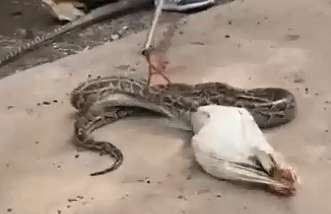It is said that animals in captivity are not as ferocious as wild animals. In order to train their hunting abilities, some zoos will consciously choose some live animals for feeding. However, the scenes of predatory animals can easily cause discomfort to people.
Recently, during a visit to a zoo in Zhengzhou, tourists discovered that in a python cage, the python was eating a rabbit, and another rabbit was trembling next to it. The scene of the python eating was somewhat disturbing. , the female visitor immediately reported it to the zoo.
The zoo staff also responded quickly: Some carnivores do not eat dead animals, but only eat animals that are jumping around. At the same time, he also said that he would choose the timing of feeding and try to feed at night in the future. There are basically no tourists during these times.
Do pythons only eat live things?
As for snakes, they do not eat carrion. They do not only eat live creatures. It is just that they are better at catching live animals, because the eyes of most snakes are almost just decorations. , are used to scare away enemies, their viewing angle is very poor. But snakes have a very special infrared eye system, which is also an infrared nest-shaped organ of snakes. It has the function of monitoring heat, that is, it can sense the infrared radiation emitted by warm-blooded animals, so that they can detect within the electromagnetic band of the radiant energy emitted by animals. See imaging of prey.

This is the same principle for pythons to capture prey. They mainly rely on infrared rays to observe the environment. The infrared nest-shaped organ allows pythons to sense the temperature emitted by other animals and accurately capture prey. Therefore, pythons are better at catching living creatures. If they are dead animals, even if they are Pythons are also difficult to spot in person.
Boas are difficult to find dead animals. It’s not that they don’t eat. What’s more, the prey that pythons eat is already dead. When the python locks on the prey, it quickly entangles the prey and strangles the prey with strong entanglement. After confirming that the prey is completely dead, the python will swallow the entire prey from the head into the snake's belly completely, so the prey will already have no life breath after swallowing the snake's belly.
If a python spits out its prey, it will injure itself
When a python encounters a threat, it will spit out its prey to make it lighter and more flexible, so that it can help the python fight back or escape. , this is a rumination ability of pythons, but pythons cannot spit out prey with just one mouth. When spitting out prey, the snake's belly, internal organs and other organs will also be scratched by the horns. Just like many pythons, when they swallow their prey, they will be hunted by sharp horns such as antlers and wild boar tusks.Things kill in return.

In August 2015, a python more than 3 meters long in India After spitting out a deer, the python neither ran away nor fought back. Instead, the snake's body continued to twist in place, causing the python to die quickly.
The python spits out prey as an act of self-preservation, but instead leads to the death of the python. How did the python's rumination become a suicidal behavior? Finally, after anatomical research, the python relied on muscle peristalsis in the process of spitting out the prey. , but the antlers and hooves of deer can easily scratch the internal organs of the snake, causing damage to the internal organs of the snake, leading to the death of the snake. Therefore, it is not easy for the python to spit out its prey. In addition, it is easy for the python to spit out prey due to the threat and pressure from the surroundings. An overreaction resulted in the death of the python.

As the temperature rises in summer, various snakes are also active During the season, when traveling in the countryside, be sure to pay attention to snakes. Whether they are venomous or non-venomous snakes, they are all aggressive to a certain extent.